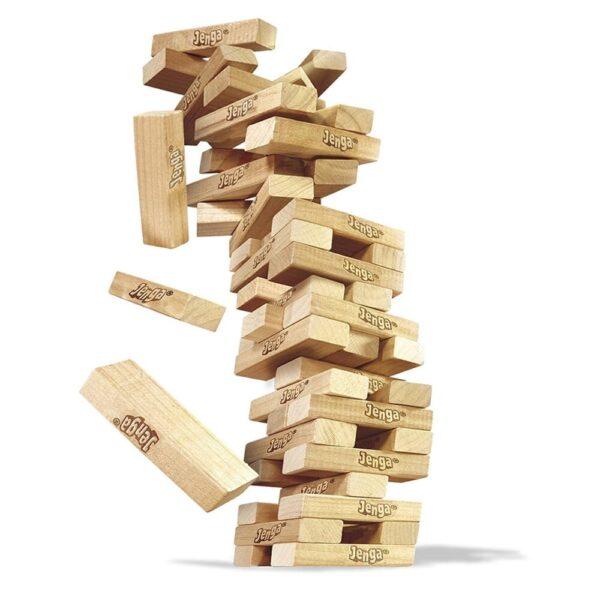Jenga is a game played with a tower of wooden blocks, and it was created by Leslie Scott in 1983. One or more players can play, and the recommended age range is six and up. Jenga’s target audience includes everyone, as kids, adults, friends, and strangers, can all easily pick up and join a game of Jenga at any time. This game does require some physical skill. Our team’s game, named Social Jenga at the moment, builds upon the mechanics of Jenga. By adding additional mechanics, different dynamics emerge and fellowship becomes a more relevant aesthetic.

In regular Jenga, the mechanics include players taking turns to remove a wooden block from any level of the tower. They must then place it on the top level without the tower falling over. If a player causes the tower to fall, then the game ends and they are deemed the loser. These mechanics result in a dynamic where tension gets built over the course of the game as the tower gets more and more unstable. I found that, even when it was not my turn to remove a block, I was still feeling very invested and on edge. When the tower does collapse, there is a huge release of tension, and it is very cathartic to scream and be dramatic. This dynamic results in feelings of fellowship, since players are all invested in what happens to the tower even when it is not their turn to interact with it. Challenge also arises, since players need to use physical skills to safely maneuver the blocks. Social Jenga requires players to essentially play Jenga, thus it shares these same mechanics, dynamics, and aesthetics relating to interacting with a precarious tower.
Again, in regular Jenga, the mechanic of losing if you knock over the tower, results in dynamics where players will adopt different strategies. Players who are more risk averse, will often take middle blocks because they are the safest to remove. Other players who like to take risks will take edge pieces to make the tower more unstable. Cooperation can form, where some players will scout out safe looking pieces, or call out advice for how to safely move a block, for other players. Competition can also manifest, as players might intentionally try to distract each other as they are moving a piece, or they may try to remove key pieces that make the structure very unstable for the next person. This again results in fellowship, where Jenga can reveal how people behave in a high stakes setting, and where each player’s actions will affect others.
In the case of Social Jenga, we are adding a mechanic where players take on roles. One person’s role is the saboteur, who wants the tower to fall, meanwhile the other players want the tower to remain standing after x number of rounds. They also want to figure out who the saboteur is. The saboteur can stay under cover by properly removing pieces, but they might also want to make the tower more unstable so that it can fall. This mechanic leads to a dynamic where a player’s moves are scrutinized by others. Thisdynamic of scrutinization can lead to greater fellowship because not only are players invested in the state of the tower, they are also invested in each player’s specific technique and behavior. The element of being watched also adds to the challenge, as people might get performance anxiety. Another mechanic we are adding is that players will have to draw from a deck of cards that dictate their next move. For example, some cards might ask players to remove an edge piece, and some cards might ask players to use their nondominant hand only. This results in a more unstable and unpredictable shape of the tower, and adds to the tension building. Players may take on more unusual behavior (for example, risk-averse players may be forced to riskier actions) which adds to the fun of seeing how other players behave when they are in different states. That is, seeing a normally calm, risk-averse player freak out about having to remove a piece with their eyes closed, lets other players see a different side of them.
Overall, with Social Jenga, we are hoping to add mechanics that place a greater emphasis on fellowship by adding an element of social deduction between players, as well as giving players a reason to observe each other as they face a hard challenge.



